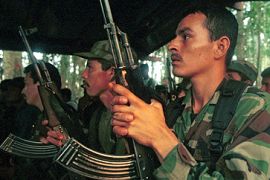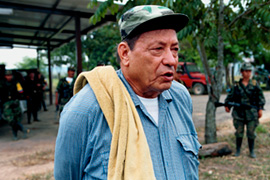Who are the Farc?
Al Jazeera profiles Latin America’s oldest rebel group.

 |
| Despite recent setbacks the Farc is far from defeated [GALLO/GETTY] |
Events in Colombia over recent months have once again thrust the Revolutionary Armed Forces of Colombia (Farc) into the spotlight.
The group has spent decades battling the Colombian government, proclaiming its struggle to be a fight for the country’s poor against their wealthy oppressors.
However the Colombian government and other detractors say the group is responsible for a string of rights abuses, including bomb attacks, kidnappings, assassinations and extortion of local businesses.
Human rights organisations have condemned the Farc’s used of child fighters and its indiscriminate targeting of civilians.
They are also accused of hypocrisy for funding much of their activities through the trafficking of cocaine, with around 65 of the group’s 110 operational units involved in the trade, according to a 2005 International Crisis Group report.
Bloody beginnings
The group’s roots lie in what is known in Colombia as “La Violencia”, a bloody period in the 1940s and 1950s sparked when Jorge Eliecer Gaitan, a popular left-wing politician, was assassinated, leading to a wave of violence between right-wing and left-wing armed groups.
 |
| Manuel ‘Sureshot’ Marulanda was the leader of the Farc for decades [GALLO/GETTY] |
The fighting left up to 300,000 people dead and spawned several groups, including the Farc, the ELN and M-19 movements.
Established in 1964 as the military wing of the country’s Communist Party (although 1966 has also been mooted as the date), the group spent the 1960s and 1970s acting as a “guerilla” force carrying out operations against the military in its heartland of the south and east of Colombia.
However, during the 1980s, the movement developed a formal army structure, organising into squads and fronts.
The group was believed to have had about 16,000 fighters in 2001, although that figure now is down to between 6,000 and 8,000, according to the government.
The group is governed by a seven-member secretariat, and was led by Manuel Marulanda, nicknamed “Tirofijo” or “Sureshot” because of his reported shooting skills, until his death from a heart attack in March 2008.
He was replaced by Alfonso Cano, the former ideological head of the Farc, the group announced in May of the same year.
Negotiations
The Farc has been involved in on-off peace negotiations with the Colombian government since 1984, when it set up a political party, the Patriotic Union, to achieve its ends.
But the party was undermined by a series of assassinations by right-wing paramilitaries and in 1985, the group returned to its armed campaign.
In 1998 the then-president of Colombia, Andres Pastrana, allocated a 42,000 square kilometre safe haven for the Farc, which had previously been a pre-condition of the group for peace talks.
However by 2002 negotiations stalled after attacks continued and Pastrana ordered the army to retake the territory.
Hostages
 |
| Protesters have demanded Ingrid Betancourt’s release [AFP] |
In an attempt to force the government to accede to its demands and to release captured fighters, the Farc has taken hundreds of hostages.
Ingrid Betancourt, a former presidential candidate, and three US military contractors, were freed following a reported Colombian military operation in July 2008.
The hostages are held in poor conditions, sometimes in cages deep in jungle areas controlled by the Farc.
One hostage released by the Farc said he and others had suffered “subhuman conditions” during their captivity.
The group has recently released some captives on what it has said are ethical grounds in a deal brokered by Hugo Chavez, the Venezuelan president, but it rejected a government deal over Betancourt, saying its fighters must be released from Colombian jails first.
Movement in decline?
In 2002 Alvaro Uribe was elected president of Colombia. A more “hardline” politician than his predecessor, his own father, a wealthy landowner, was assassinated by the Farc during a failed kidnapping attempt.
Uribe has intensified the Colombian military assault on the Farc and the Colombian army’s better-equipped forces, trained and advised by the US, have scored a number of significant victories.
A number of senior commanders have been killed, including Raul Reyes, who died in a controversial a cross-border raid on Farc camp in Ecuador by the Colombian military, which sparked a still lingering diplomatic crisis in the region.
The group has also suffered a number of desertions as fighters became disillusioned with the group’s involvement in the drug trade.
But while the group has suffered a number of setbacks, it is far from defeated.
Chavez has offered Farc vocal support and earlier this year called for the group and the smaller ELN organisation to be removed from government lists of terror groups.
And the Colombian government may now be more wary of carrying out cross-border military operations against the Farc, after Latin American governments reacted angrily to its raid into Ecuador.